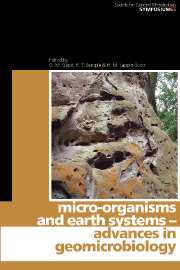Book contents
- Frontmatter
- Contents
- Contributors
- Editors' Preface
- Isotopic-labelling methods for deciphering the function of uncultured micro-organisms
- Biofilms and metal geochemistry: the relevance of micro-organism-induced geochemical transformations
- Minerals, mats, pearls and veils: themes and variations in giant sulfur bacteria
- Soil micro-organisms in Antarctic dry valleys: resource supply and utilization
- New insights into bacterial cell-wall structure and physico-chemistry: implications for interactions with metal ions and minerals
- Horizontal gene transfer of metal homeostasis genes and its role in microbial communities of the deep terrestrial subsurface
- Biosilicification: the role of cyanobacteria in silica sinter deposition
- Metabolic diversity in the microbial world: relevance to exobiology
- Biogeochemical cycling in polar, temperate and tropical coastal zones: similarities and differences
- Fungal roles and function in rock, mineral and soil transformations
- The deep intraterrestrial biosphere
- Iron, nitrogen, phosphorus and zinc cycling and consequences for primary productivity in the oceans
- Mechanisms and environmental impact of microbial metal reduction
- New insights into the physiology and regulation of the anaerobic oxidation of methane
- Biogeochemical roles of fungi in marine and estuarine habitats
- Role of micro-organisms in karstification
- Index
Metabolic diversity in the microbial world: relevance to exobiology
Published online by Cambridge University Press: 06 July 2010
- Frontmatter
- Contents
- Contributors
- Editors' Preface
- Isotopic-labelling methods for deciphering the function of uncultured micro-organisms
- Biofilms and metal geochemistry: the relevance of micro-organism-induced geochemical transformations
- Minerals, mats, pearls and veils: themes and variations in giant sulfur bacteria
- Soil micro-organisms in Antarctic dry valleys: resource supply and utilization
- New insights into bacterial cell-wall structure and physico-chemistry: implications for interactions with metal ions and minerals
- Horizontal gene transfer of metal homeostasis genes and its role in microbial communities of the deep terrestrial subsurface
- Biosilicification: the role of cyanobacteria in silica sinter deposition
- Metabolic diversity in the microbial world: relevance to exobiology
- Biogeochemical cycling in polar, temperate and tropical coastal zones: similarities and differences
- Fungal roles and function in rock, mineral and soil transformations
- The deep intraterrestrial biosphere
- Iron, nitrogen, phosphorus and zinc cycling and consequences for primary productivity in the oceans
- Mechanisms and environmental impact of microbial metal reduction
- New insights into the physiology and regulation of the anaerobic oxidation of methane
- Biogeochemical roles of fungi in marine and estuarine habitats
- Role of micro-organisms in karstification
- Index
Summary
INTRODUCTION
Metabolic diversity is used here as a physiological or ecological concept referring to the metabolic repertoire available to any group of organisms: in this case, microbes. At least for now, metabolic diversity is conceptually distinct from genetic diversity, although one imagines that, as both concepts are understood in greater depth, the relationships between them will become clear. The metabolic repertoire encompasses, for the most part, the entire range of redox-related energy sources that are available on our planet, from photochemistry to organic and inorganic redox chemistry. Earthly microbes have ‘learned’ to harvest the energy of nearly every useful and abundant redox couple, revealing a nutritional versatility that to some extent could be used to describe what the planet has to offer energetically. To turn this around, one can imagine that, if energy sources were defined for Earth, one might well predict what kinds of metabolism should have evolved to exploit them and, in fact, for the most part, this would lead to the correct answer. Metabolic diversity is further accentuated by various symbioses, syntrophisms and community interactions (intracellular, intercellular and interpopulation), leading to the establishment of communities with seemingly new and unexpected abilities. The functional diversity of the prokaryotic world is thus expressed in terms of its redox chemistry and, with regard to geobiology, this redox chemistry/metabolic connection defines a wide variety of relevant reactions, many of which involve phase changes of the interacting molecules (i.e. between solid, liquid and gas phase).
- Type
- Chapter
- Information
- Micro-organisms and Earth Systems , pp. 151 - 172Publisher: Cambridge University PressPrint publication year: 2005
- 4
- Cited by

